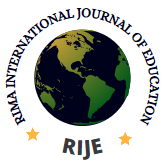Domestic Violence against Women and Children and Ways of Prevention: Implications for Counselling
Mohammed Murjanatu Sallah
Department of Educational Foundations, Faculty of Education and Extension Services, Usmanu Danfodiyo University, Sokoto
Bello Tayibat Shinco
Department of Educational Foundations, Shehu Shagari Collage of Education, Sokoto
Abstract
Domestic violence against women and children is growing at alarming rate, which calls for the intervention of leaders as well as counsellors. This paper examines the issue of domestic violence against women and children. Various concepts of domestic violence were discussed, types of domestic violence which include: physical, emotional or psychological, neglect and other forms of domestic abuse or violence such as yelling, shouting as well as financial abuse were highlighted. The paper also examined some effects of domestic violence both physical and emotional such as: swelling of the body, broken limbs, bruises, attitudinal change to others, depression and many others. Theories related to domestic violence were also discussed as well as empirical related studies. The paper provided some preventive measures to stop domestic violence and finally the writer suggested possible ways to stop domestic violence by involving the community, religious leaders, professional counsellors, school counsellors as well as policy makers. Pre-marital counselling should be given to the intending couples on how to manage their marital relationship.
Keywords
Domestic violence, Women, Children
Reference
Abubakar, H. S., Bagudo, A. A. & Musa, F. B. (2015). Causes and Pattern of Wife Abuse among Couples in Sokoto State. Issues in the helping profession for Nigerian Counsellors, pp. 321-328.
Agu, Z. (2018). Causes of domestic violence. Retrieved on 26/5/2019 from https://www.legit.ng>causes of domestic violence.
Akinleke, W. O. (2018). Incidence of Domestic Violence Against Married Women in Yewa South Local Government Area of Ogun State, Nigeria. International Journal of Sociology and Antropology Research. Vol.4, No.5, pp 38-46.
Akpan, I. D.&Usoroh, C. I. (2005). Domestic violence during pregnancy. International journal of violence and related studies, 1: 15-26.
Bitangora, B. (1999). “Rape, the silent cancer among female refugees”. In conveying concerns: women’s report on gender based violence Washington: Population references bureau (2000) measure communication.
CDC (2011). Centre for Disease Control and Prevention, Youth risk Behaviour, Surveillance System (YRBSS 2009) National Youth Survey Behaviour overview. Retrieved from:http://www.cdc.gov.healthyouth/yrbss/pdf/usoverviewyrbss.pdf.
Ellisberg, M., Heise, L., Pena, R., Agurto, S. &Winkrist, A. (2001). “Researching Domestic Violence against Women: Methodological and Ethical Considerations Studies in Family Planning Journal, 32 (1): 1-16 from https:/doi org/10-1111/j.1728-4465 2001 0001.x
Goode, W. J. (1971). ‘Force and Violence in the Family’. Journal of Marriage and Family, pp624-636 quoted in supra note, 36: 175.
Manikam, S. (2012). A literature Review on Domestic Violence Campaign and the use of Technology as a Preventing Strategy. School of Advertising, Marketing and public relation queens land University of Technology. Pp 1.
Mouzos, J. & Makkai, T. (2004). Women’s Experience of Male Violence: Findings from the Australian components of the international violence against women survey (IVAWS) research and public policy series no.56. cambera: Australian institute of criminology. Retrieved from http//www.aic.gov.au/documents/5/8/%7B58D8592E-CEF7-4005-AB11-B7A884842399%7DRPP56Pdf.
Musawa, H. (2016). Surging Domestic Violence rate against Women in Nigeria.Retrieved from:www.https://nationonlinenet>surging-domesticviolence.
Olson, D. H. & Defrain, J. (2006). Marriages and Families.Intimacy and Diversity and Strength, Fifth edition. University Minnesota and university of Nebraska United States America.
Samiah, O. (2022). Premium times 28 march 2022. Pp 1-2 from https;//allafrica.com.
United Nation General Assembly (1973). Equal Rights for Women. A call for Action. The United Nations Declaration on the Elimination of Discrimination against Women.
United Nations General Assembly (1993). Declaration on Elimination of Violence against Women, Proceedings of the 85th Plenary Meeting, Geneva, December 20, 1993.
United Nations Individual Children Education Fund (2007). Assessment of Violence against Children at the Basic Education level in Nigeria, Federal Ministry of Education in Collaboration with Unicef.
Walker, L. E. (1978). Theories and Causes of Domestic Violence. Retrieved from https://shodhganga.inflibnet.ac.in>bitstr(pdf)on 6/11/19.
World Health Organisation (WHO), Geneva. (2002). Prevention of violence: a summary on public health priority resolution WHA49.25 in: world report on violence health.
World Health Organisation WHO, (2017). Violence Against Women. Retrieved from https://www.who.int.violenceagainstwomen.
Women Aid Collective, (2004). Menace of Domestic Trafficking. A Study Conducted by Women’s Aid Collective (WACOL) Nigeria.
Yogo, N. (2008). Impact of Domestic Violence against Women. A case study of Baba1 Community University of Buea, Cameroon.Unpublished Material.
Zadding, C. S. (2012). Assessment of Domestic Violence and Abuse against Women and its effects on Family Relationship in four Selected Local Government in Taraba State.
